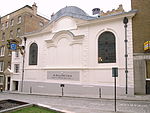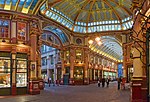Kleinwort Hambros
Banks established in 2016Banks of the United KingdomEconomy of the City of LondonEuropean bank stubsFinancial services companies established in 2016 ... and 2 more
Investment banksUnited Kingdom financial services company stubs

Kleinwort Hambros is a private bank owned by Société Générale that offers financial services from offices throughout the United Kingdom and Channel Islands. Kleinwort Hambros focuses on private banking, providing a range of services for high net worth individuals and corporate clients, managing liquid and illiquid assets including a provision of corporate advice and private office capabilities.
Excerpt from the Wikipedia article Kleinwort Hambros (License: CC BY-SA 3.0, Authors, Images).Kleinwort Hambros
Fenchurch Street, City of London
Geographical coordinates (GPS) Address Website Nearby Places Show on map
Geographical coordinates (GPS)
| Latitude | Longitude |
|---|---|
| N 51.511388888889 ° | E -0.083333333333333 ° |
Address
Fenchurch Street 20
EC3M 6BQ City of London
England, United Kingdom
Open on Google Maps











